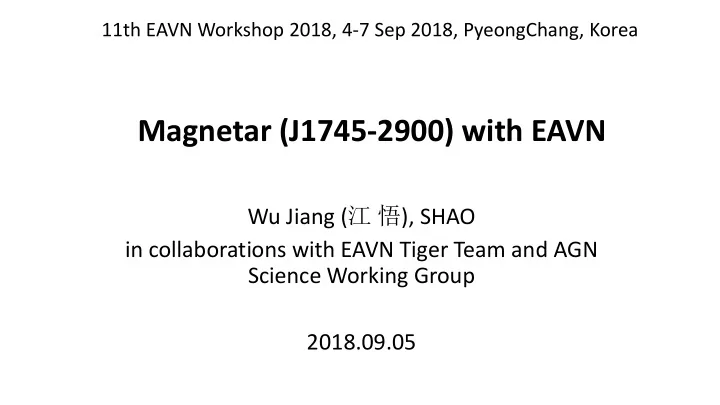

11th EAVN Workshop 2018, 4-7 Sep 2018, PyeongChang, Korea Magnetar (J1745-2900) with EAVN Wu Jiang ( 江 悟 ), SHAO in collaborations with EAVN Tiger Team and AGN Science Working Group 2018.09.05
Motivations Rare Share Cadence Increase
Discovery of magnetar J1745-2900 First profile -Swift BAT (X-ray) Kennea et al. ApJL, 2013
Radio emission of Magnetar J1745-2900 Jul-Aug, 2014 Apr-May, 2013 Mar, 2015 Eatough et al, Nature, 2013 Torne et al, MNRAS, 2015 Torne et al, MNRAS, 2017
Radio spectral index of Magnetar J1745-2900 Jul-Aug, 2014 Mar, 2015 a = - 0.4 ± 0.1 a = + 0.4 ± 0.2 Torne et al, MNRAS, 2015, 2017
Magnetar-SgrA* Neighbor to SgrA* Magnetar (Soft Gamma Repeater, SGR) A 2.4" projected distance translates in a minimum physical separation d = 0.09+/-0.02 pc (90% CL) for D=8.3 kpc 2.4" CHANDAR picture http://chandra.harvard.edu/photo/2015/sgr1745/
Magnetar J1745-2900 vs. EAVN VLA, 7mm 2.4" A 2.4" separation means magnetar-SgrA* shares the in/same beam even for Tianma65 in Q band (22"). Share similar physical conditions with SgrA* Kravchenko et al. MNRAS, 2016 Share LP monitoring of SgrA* High frequency astrometry
Magnetar J1745-2900 vs. EAVN High frequency (K/Q): Invert spectrum, reduce the scattering effect Share the same observation with SgrA*, increase the target source but no additional observation time Feed back to SgrA* data analysis RMS (image of SgrA): 0.3 mJy@K, 1 mJy@Q
Magnetar J1745-2900 with VLBA+VLA VLBA, 8.7 GHz VLBA, 15.4 GHz Bower et al. ApJL,2014
Proper motion of magnetar J1745-2900 Bower et al. ApJ,2016
First trial with EAVN campaign 2017 data Obs. Date Sources Freq. Obs summary of A17086A a17077a Mar 18 UT12:45-19:45 M87 K a17078a Mar 19 UT11:40-18:40 M87 Q Date March 27, 2017 a17086a Mar 27 UT13:10-23:10 M87+SgrA Q Stations KaVA+Tianma a17093a Apr 3 UT13:20-23:25 M87+SgrA K Freq 43G, Q band in LCP a17094a Apr 4 UT12:35-22:35 M87+SgrA Q Bandwidth 8IF*32MHz=256 MHz a17099a Apr 9 UT12:20-22:20 M87+SgrA Q Scan length 780 sec each a17104a Apr 14 UT12:00-22:00 M87+SgrA Q a17107a Apr 17 UT11:45-18:45 M87 K Raw data transfer KJCC to SHAO a17108a Apr 18 UT11:40-21:40 M87+SgrA Q a17114a Apr 24 UT09:20-16:20 M87 K Correlated with SHAO-DiFX for: a17115a Apr 25 UT09:15-16:15 M87 Q 1. Radio profile of magnetar a17116a Apr 26 UT15:55-21:55 SgrA Q 2. Imaging magnetar with pulsar binning/gating a17130a May 10 UT08:20-17:20 M87 K a17131a May 11 UT08:15-17:15 M87 Q 3. … a17145a May 25 UT14:10-20:12 SgrA Q a17146a May 26 UT07:20-14:20 M87 Q
Profile of magnetar Raw profile from correlator Single pulses vs. time -3 Data and Fits x 10 20 y vs. x 15 Profile at 43G 10 5 0 -5 0 100 200 300 400 500 600 700 800 900 1000 Residuals 0.01 0.005 0 -0.005 -0.01 0 100 200 300 400 500 600 700 800 900 1000 SNR will be improved by 2 times with pulsar gating. S. Chatterjee et al. 2018
Chandra monitoring of magnetar J1745-2900 Coti Zelati, et al, MNRAS, 2017 ~3.5 yr MJD 56424 MJD 57588 Raw profile from correlator 0.02 0.02 0.015 0.015 0.01 0.01 0.005 0.005 0 0 -0.005 -0.005 Profile from Chandra -0.01 -0.01 0 0.1 0.2 0.3 0.4 0.5 0.6 0.7 0.8 0.9 1 0 0.1 0.2 0.3 0.4 0.5 0.6 0.7 0.8 0.9 1
Image of Magnetar Phase center @ magnetar Fake image of magnetar Fringes of “ magnetar ”
Image of Magnetar Magnetar SgrA* Response of two element interferometer 1.2 single dish beam 1 two element beam 0.8 0.6 0.4 0.2 0 -0.2 -5 0 5
Image of Magnetar, a second try Phase center A @ SgrA*, Phase center B @ Magnetar In beam phase-referencing calibration SgrA* Dirty map of phase-referenced Magnetar
Summary 1. Magnetar(J1745-2900) seems could be detected by EAVN in the Q band, K band data under check. 2. A good model of SgrA* is important to subtract its contamination to the beam, testing the model? 3. Data processing in other epochs are still ongoing. 4. Dig the GC area beginning with Magnetar. Thank you !
Recommend
More recommend